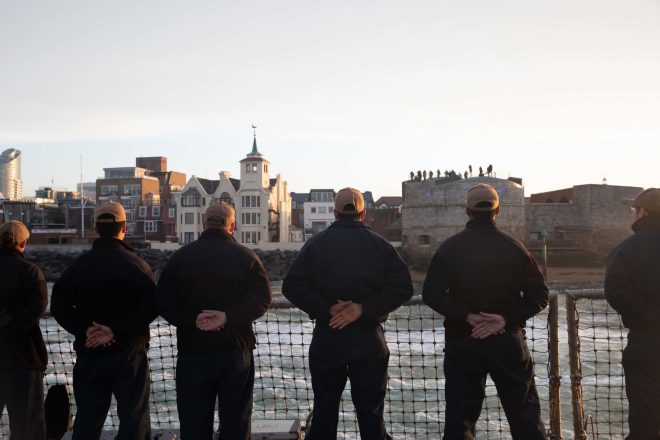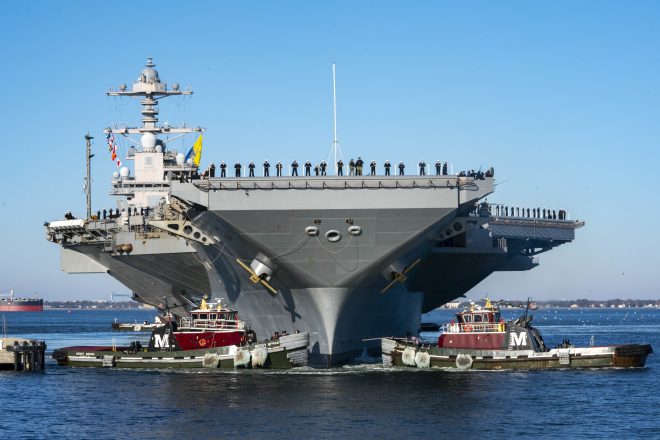Hamartia Antidote
ELITE MEMBER

- Joined
- Nov 17, 2013
- Messages
- 35,188
- Reaction score
- 30
- Country
- Location

USS Gerald R. Ford departs for its first major deployment - Naval News
The lead ship of the US Navy’s newest class of nuclear-powered aircraft carrier, USS Gerald R. Ford (CVN 78), departed today from Norfolk, Virginia, on its first major deployment.
The carrier’s planned leaving date for Monday October 3 was postponed the day before due to weather conditions. The carrier is scheduled to deploy next year in support of regional combatant commanders.
USS Gerald R. Ford is conducting what the US Navy calls a “service-retained” deployment, meaning it is operating by the authority of the chief of naval operations under command and control of the U.S. 2nd Fleet, rather than under the command and control of a regional combatant commander under the Global Force Management Concept (GFMC).
Speaking to reporters on September 26, Vice Adm. Daniel Dwyer, commander of the US 2nd Fleet said that CSG 12, which the Ford carrier is leading, will range throughout the Atlantic Ocean operating with navies of allied and partner nations.
The deployment would provide the Ford CSG commander “a chance to test the carrier’s air operability prior to embarking on its first Global Force Management deployment next year”, highlighted the commander of the US 2nd Fleet during the media phone conference.
Units and aircraft from eight allied and partner nations will operate with the CSG 12 including assets from Canada, Denmark, Finland, France, Germany, The Netherlands, Spain and Sweden. The CSG includes 17 ships and one submarine.“This historic service-retained deployment is an opportunity for the U.S. Navy to come together with other members of the NATO Alliance to exercise and train together within the Atlantic and its littorals while testing out advanced technologies on the first new class of U.S. aircraft carrier in more than 40 years”
Vice Adm. Daniel Dwyer, US 2nd Fleet commander
The Gerald R. Ford Carrier Strike Group (GRFCSG) deployment include Carrier Strike Group (CSG 12), Carrier Air Wing 8 (CVW 8) and Destroyer Squadron (DESRON) 2. Deploying with the group will be Ticonderoga-class guided missile cruiser USS Normandy (CG 60); the Arleigh Burke-class guided missile destroyers USS Ramage (DDG 61), USS McFaul (DDG 74), and USS Thomas Hudner (DDG 116); the Legend-class national security cutter USCGC Hamilton (WMSL 753); the Henry J. Kaiser-class fleet replenishment oiler USNS Joshua Humphries (T-AO 188), and the Lewis and Clark-class dry cargo and ammunition ship USNS Robert E. Peary (T-AKE 5).
“Innovation and interoperability are the key focal points of this deployment,” Dwyer said. “And we will work together with allies and partner nations to strengthen our collective defense of the Atlantic by maturing our integration for future maritime operations.”
While deployed, the Ford CSG will conduct group steaming, air defence exercises, maritime domain awareness, long-range maritime strikes, distributed maritime operations, antisubmarine warfare exercises, as well as naval integration, Dwyer said.
All eight squadrons of Carrier Air Wing Eight, comprising F-18 E/F Super Hornets, E-2D Advanced Hawkeyes and EA-18G Growlers along with MH-60 Sierra and MH-60 Sea Hawk helicopters, will be onboard for the deployment but some will not be at full strength in terms of numbers of aircraft. “It won’t be the full complement, but it will be nearly the entire air wing,” Dwyer explained. “And that is not because of any lack of capacity aboard Ford, but only where the air wing is in the Global Force Management process. We’re still sizing the numbers, but it will be a fairly full air wing, but not the complete air wing,” he specified.“This deployment is an opportunity to push the ball further down the field and demonstrate the advantage that Ford and Carrier Air Wing (CVW) 8 bring to the future of naval aviation, to the region and to our Allies and partners,”
Rear Adm. Gregory Huffman, commander, Carrier Strike Group (CSG) 12


